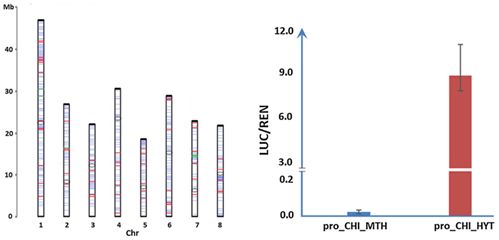Name:Yuepeng Han
Tell:
Email:yphan@wbgcas.cn
Organization:Wuhan Botanical Garden
Researchers Reveal Evolution Mechanism of ‘Moshan’ Transposable Elements in Peach Genome
2016-04-06
“Peach blossoms, a full tree of crimson red, sounded like a remark of spring”. With various morphology and colors, peach blooms at early spring, which is adored by poets. Its uniqueness also attracts researchers.
Transposable elements (TEs), grouped into retrotransposons (class I) and DNA transposons (class II), are widely distributed in almost all organisms, and occupy a large fraction of many eukaryotic genomes. In peach, TE sequences account for approximately 30 % of the genome. However, the evolutionary origin and functionality of TE remain largely unclear.
Supervised by Prof. HAN Yuepeng, assistant researcher WANG Lu from Wuhan Botanical Garden found a class of hAT-MITE (miniature inverted-repeat transposable element) transposon (‘MoShan’ transposon) in peach genome. The physical location of ‘MoShan’ transposons in genome, and the relationship between these transposable elements and functional genes were studied.
The ‘MoShan’ transposons were very active, and the copy number of ‘MoShan’ transposons extended to nearly 500 copies in the peach reference genome, of which 39 were inserted into the gene regions. In each of tested peach cultivated varieties and wild species which had been analyzed by whole genome resequencing method, about 200 or more ‘MoShan’ transposons new insertion sites were characterized.
It also revealed the regulation of ‘Moshan’ transposon on the close gene’s expression, as well as the origin and evolutionary history of this transposon class.
This work illustrated the contribution of transposons to the genetic polymorphism among peach cultivars, and provided evidence of peach domestication and evolution history.
Research results entitled “Evolutionary origin ofRosaceae-specific active non-AutonomoushATelements and their contribution to gene regulation and genomic structural variation” were published in Plant Molecular Biology.
It was supported by the National Natural Science Foundation of China, the Overseas Construction Plan for Science and Education Base, China-Africa Center for Research and Education, Chinese Academy of Sciences, and the National 863 program of China.

Distribution of MoShan transposons in peach genome and their potential regulation to the expression of close functional genes (Image by WANG Lu)